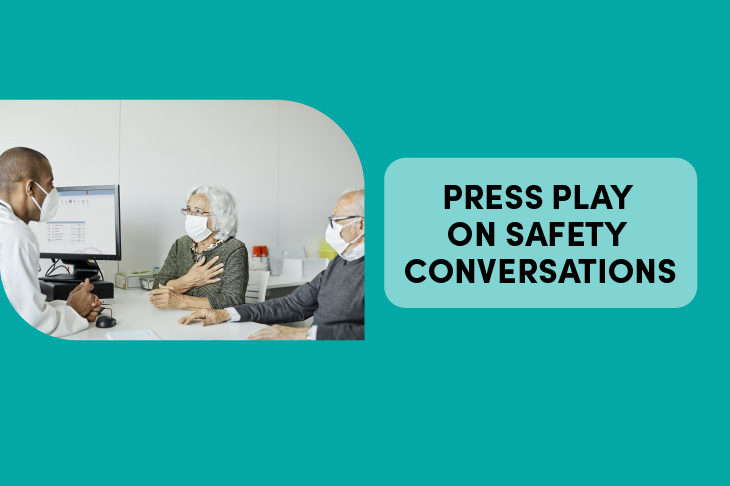By Jennifer Zelmer and Jim Silvius
Everyone wants and deserves safe care. Yet with health systems under strain, risks of unintended harm can grow. A focus on patient safety – which goes hand-in-hand with the safety of people working in healthcare – is more important than ever.
Safety happens by design, not by luck. This is particularly crucial for older adults who are more likely to experience some types of harm in healthcare. They also tend to feel less involved in decision-making and treatment options than compared to younger counterparts. Particularly if they are thought to have memory changes.
Jim: For instance, when I’m mentoring students, I’ll remind them to speak directly with a patient rather than only asking questions of an accompanying family member.
Together, we can work to create safety, reduce unintended harm, and act on and learn from errors. One way to do this is by Pressing Play on Safety Conversations, the theme of this year’s Canadian Patient Safety Week.
What are safety conversations?
Care improves for everyone when we prioritize talking about safety and acting on insights from what we hear. Safety conversations give people involved in care a chance to explore, share, learn or just talk about what matters to them and makes them feel safe. It’s not about additional tasks or projects but rather how we do the work we do. Safety conversations can involve those who are organizing, delivering, seeking, or receiving care, such as healthcare providers, patients and family or other essential care partners.
Jennifer: A few years ago, I joined a conversation with a relative’s care team prompted by her concerns about her prescribed medications. Together, we spoke about her concerns. Focusing on what mattered to her led to a change in her prescriptions and safer approaches to managing her pain.
And it needs to feel - and be - safe to have safety conversations for everyone involved! We need to create opportunities, recognize that many people are uncomfortable or afraid of questioning their providers, and invite dialogue and encourage effective responses. In doing so, we need to recognize and adapt to different contexts and needs. Such as whether care is in-person or virtual, whether those having the conversation have just met or have an ongoing relationship grounded in trust, or whether patients and care providers speak different languages or come from different backgrounds.
Jim: All behaviour is communication. Some of the patients I see are no longer able to speak because of cognitive difficulties, but they communicate about what makes them feel safe and what does not in other ways.
Whenever and wherever care is being provided, consistent and effective safety conversations give everyone a chance to create safety together.
Why have safety conversations?
Positive safety cultures are better for patients and for people working in healthcare. Organizations with such cultures tend to have less patient harm and higher staff satisfaction.
Jim: Many patients referred to me today are frailer and have had less access to in-person care since the beginning of the pandemic. By asking questions about what matters to them now and acting on their experiences and what I hear, I can offer safer care that reflects their current situation and needs.
Safety conversations change the way we think about safety, moving towards a more holistic, shared and consistent view of safety rather than just focusing on past harm. This includes actions that create safety in a proactive and predictive way. Having these conversations helps to reveal varied perspectives on safety and illuminates how people see, experience, and contribute to creating safety. From there, we can begin to understand what harm – as well as feeling and being safe – means to everyone involved and how to make care safer. Equity and respect are foundational to safety.
Ready to “press play on safety conversations”?
Join us and others from coast to coast to coast during Canadian Patient Safety Week 2022 (October 24 to October 28, 2022) and beyond. Share your insights, learn from others and fine-tune your safety conversations.
- Dig deeper into safety conversations at the Now is the Time to Press Play on Safety Conversations webinar.
- Take action through the Safety Conversations Action Series.
- Learn more from our list of quality and safety tools and resources to help you make care safer for older adults.
- Read Is it time to review your medications? and 5 questions to ask about your medications.
- Visit SafetyConversations.ca.
About Canadian Patient Safety Week (CPSW)
Canadian Patient Safety Week (CPSW) is an annual campaign that started in 2005 to inspire extraordinary improvement in patient safety and quality across Canada. CPSW is a partnership between Healthcare Excellence Canada and Patients for Patient Safety Canada. CPSW occurs annually in October with CPSW 2022 running from October 24 to October 28, 2022.
Jennifer Zelmer is President and CEO of Healthcare Excellence Canada.
Jim Silvius is a geriatrician and a founding member of the Canadian Medication Appropriateness and Deprescribing Network (CADeN)
